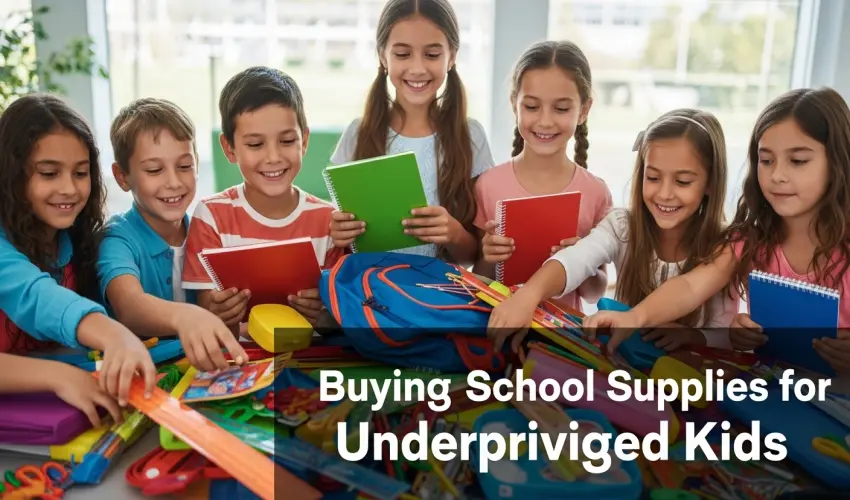Buying School Supplies for Underprivileged Kids: A Guide to Empowering Students and Supporting Education
Change a child's future with a simple backpack. Our guide explains how donating school supplies empowers underprivileged students, supports teachers, and builds stronger communities. Find out how you can help today.
Key Takeaways
-
Access to basic school supplies is critical for a child’s ability to learn, participate, and succeed, yet millions of kids lack these materials.
-
Donating school supplies empowers students, relieves financial burdens on low-income families, and supports educators in underserved communities.
-
Essential supplies include backpacks, notebooks, pencils, pens, folders, calculators, and hygiene kits.
-
Individuals, organizations, and businesses can all contribute through donation drives, fundraisers, sponsorships, or direct purchases.
-
Even a small contribution can have a big impact, boosting a child's confidence, attendance, and engagement.
-
Giving school supplies is not just about objects; it’s about giving hope, dignity, and the chance to dream.
Introduction: The Power of a Pencil
In many parts of the world, millions of children go to school every day without the basic tools they need to learn. No notebooks to write in, no pencils to take notes with, no backpack to carry their books. While these items may seem small, their absence can have a devastating impact on a child’s education, confidence, and future.
But there is good news: you can help. One of the most direct and meaningful ways to support education is by buying school supplies for underprivileged kids. This guide will show you why it matters and how you can make a difference.
The Reality: Why So Many Kids Lack Basic Supplies
The lack of school supplies is a systemic barrier to learning. Here are the primary reasons it happens:
-
Poverty: Low-income families must often prioritize food, shelter, and medical care over school materials.
-
Unemployment or Low Wages: Parents working multiple low-wage jobs may struggle to cover basic school-related expenses.
-
Large Family Sizes: Families with many children may be unable to afford individual supplies for each student.
-
Refugee or Migrant Backgrounds: Displaced families often arrive with no resources to buy books, uniforms, or stationery.
-
Underfunded Schools: In many public schools, teachers are forced to buy classroom supplies from their own pockets or simply go without.
The Hidden Impact of Lacking Supplies
The absence of a simple notebook or calculator affects far more than just schoolwork. It impacts a child’s emotional well-being and self-worth.
-
Lower Academic Performance: Without the right tools, students quickly fall behind.
-
Embarrassment and Shame: Children without supplies may feel excluded, different, or even be mocked by their peers.
-
Increased Absenteeism: The feeling of being unprepared can lead to disengagement and missed school days.
-
Teacher Burnout: Educators feel strained when spending their own money or adapting lessons for students without materials.
What Supplies Are Most Needed?
Here’s a checklist of commonly needed school supplies that can make a difference for students at any grade level:
Basic Essentials
-
Notebooks (lined, unlined, graph)
-
Pens (blue, black, red) and pencils (#2)
-
Erasers and pencil sharpeners
-
Crayons, colored pencils, and markers
-
Rulers, folders, and binders
-
Highlighters, glue sticks, and scissors
Back-to-School Staples
-
Backpacks
-
Lunch boxes and reusable water bottles
-
Pencil cases
Technology and Tools
-
Calculators (basic and scientific)
-
USB flash drives
-
Headphones (for computer lab use)
Hygiene and Wellness Kits
-
Hand sanitizer and tissues
-
Toothbrush and toothpaste
-
Soap and shampoo
A small gesture goes a long way. To a child, a new backpack filled with fresh supplies can feel like a new beginning.
How You Can Make a Difference
There are countless ways to get involved, whether as an individual, a group, or a business.
-
Direct Donation: Buy supplies yourself and drop them off at a local school, shelter, or non-profit. Always call ahead to ask for their specific needs.
-
Organize a School Supply Drive: Gather friends, coworkers, or classmates and launch a drive in your community. Promote it on social media and at local businesses.
-
Sponsor a Student or Classroom: Some non-profits allow you to sponsor individual students or entire classrooms with customized supply kits.
-
Support Existing Organizations: Many reputable charities have back-to-school programs. Look into organizations like:
-
United Way
-
Kids in Need Foundation
-
Cradles to Crayons
-
DonorsChoose (supports specific teacher projects)
-
-
Host a Fundraiser: If you don’t have time to collect supplies, raise money and donate the proceeds. Ideas include bake sales, car washes, or online donation campaigns.
Involving Kids in the Process of Giving
Teach your own children about empathy by involving them directly:
-
Let them shop for the supplies with you.
-
Have them write encouraging notes to include in the backpacks.
-
Encourage them to donate a portion of their allowance.
Conclusion: Empowering Futures, One Pencil at a Time
Education is a powerful equalizer, but it only works when children have the tools to succeed. Buying school supplies for underprivileged kids is an investment in the next generation. It tells a child:
“You matter.”
It tells a teacher:
“You’re not alone.”
It tells a community:
“We care.”
Let’s work together to fill their backpacks—and their futures—with hope.
Join the conversation
Share how this story resonates with your journey. We feature standout reflections in our newsletter.

